The article will analyze the process of laying paving on sand: the technology of laying paving slabs has its own characteristics depending on the type of base, and these features will be considered. You can study the main types of tiles (forms), find out the prices for turnkey services, learn how to prepare a dry mix intended for paving paths, and calculate materials.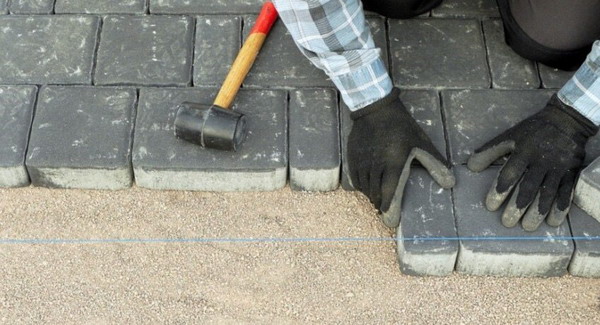
Paving slabs – a fairly popular and practical solution for paving footpaths
Laying paving slabs on sand: paving technology on different types of foundations
Improvement of the local area on a suburban area begins with planning. To purchase material for turnkey paving slabs, some features of the paving technology and factors that may affect it should be taken into account.
First of all, pay attention to the following points:
- what soil will be used as a basis;
- what stresses will be expected to be covered in the future;
- what kind of relief has a surface allotted for paving;
- what area will be covered with tiles;
- how will the paving of the tile coating be carried out.
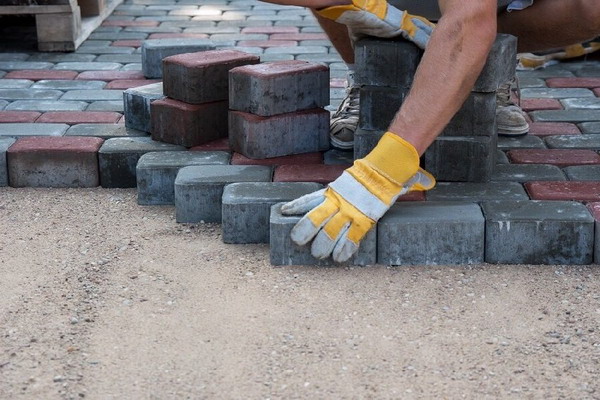
The process of laying paving slabs
Having set the goal of laying paving slabs in the country, first you need to determine the budget for such construction. Based on this, it is already possible to select the design, coating option and the base on which the sidewalk will be installed.
There are several ways of paving depending on the type of base:
- scuffing;
- screening out;
- sand;
- concrete;
- asphalt;
- dry mix.
Note! In each of these options, you will deal with both advantages and disadvantages, which relate to laying paving slabs on sand and paving on other types of substrates.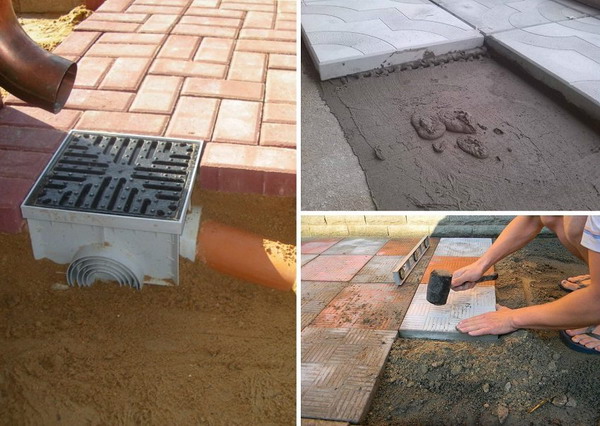
At the end of the work, it is necessary to check the surface with a level and hammer the protruding tiles with a rubber hammer
Technology of laying paving slabs at the dacha for paving and screening
The paving method for pavement coating is performed when the sidewalk or platform is under significant slope. In this case, to perform the laying of paving slabs on a sand-cement mixture, it will be necessary to maintain the proportions of materials 6: 1, where sand must be taken in 6 parts, and cement – 1.
Advantages of technology:
- The ability to seize upon contact with liquid.
- High tack fixation strength.
- It excludes the movement of tiles from their place to the side of the slope under the action of gravity.

Place the tile in such a way that it fits snugly together
The disadvantages include the process of work, which should be accelerated. The paving technology is complicated due to the fact that the parchment cannot be stored for a long time with wet sand. Under the influence of moisture in the cement, setting is activated, so you need to act very quickly, while maintaining accuracy.
Waste from gravel, also called screening, is characterized by less shrinkage than sand. Such a base is easy to level, as well as tamping. The advantage of the technology is that screenings can fully replace the crushed stone pillow. In addition, a concrete mixture of high quality can be made from screenings.
Disadvantages of this method are also present. Using this technique of laying paving slabs at the cottage on unstable soils, you will definitely have to form a pillow of crushed stone to organize a drainage layer for normal water waste.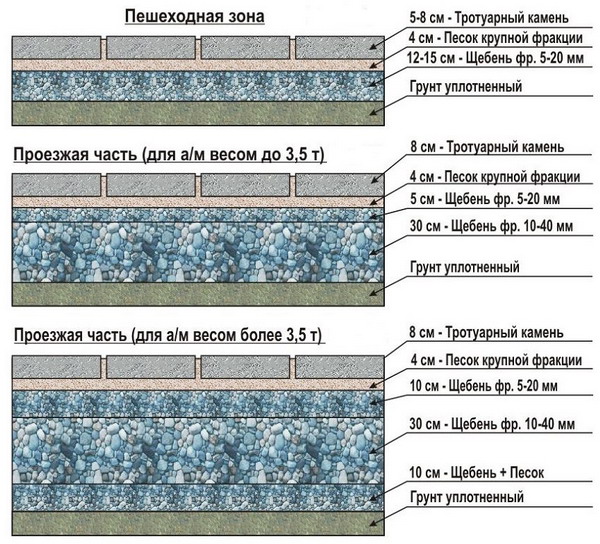
Tile paving technology for the pedestrian zone and roadway
Technology for laying paving slabs on sand and concrete
The use of a concrete base for paving sidewalks requires the use of reinforcing elements. For these purposes, it is recommended to use reinforced plates with a cellular structure. Concrete mix will subsequently be poured into these voids.
This paving technology offers two significant advantages. On the one hand, the coating acquires a high level of strength, on the other – thanks to this, the sidewalk is able to withstand severe loads in intensive use. The disadvantages include the high cost of such construction.
Sand cushion paving technology is one of the classic pavement design methods. On this type of foundation, even a special rubber coating designed for tracks can be laid.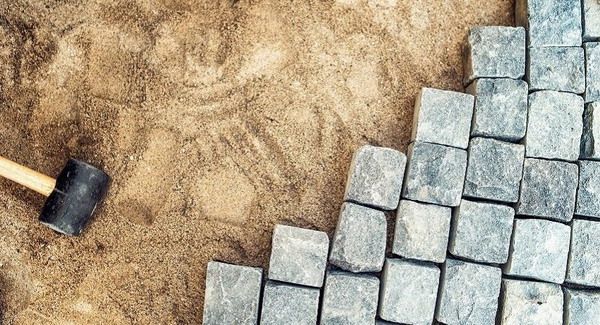
Sand cushion for paving stones or paving slabs
Helpful advice! When laying do-it-yourself paving slabs on sand, use a special tool (wooden mallet, rubber mallet) to prevent damage to the coating.
Work with a sandy surface is characterized by simplicity. The pavement can be done in this case even with your own hands. But this does not mean that the technology does not require certain efforts and efforts on your part.
There are also negative aspects of the technology, which involves paving tiles on the sand. The base can be washed out from under the tile during heavy rains. To avoid this, you need to install special borders around the perimeter of the track. Their installation significantly complicates the technology.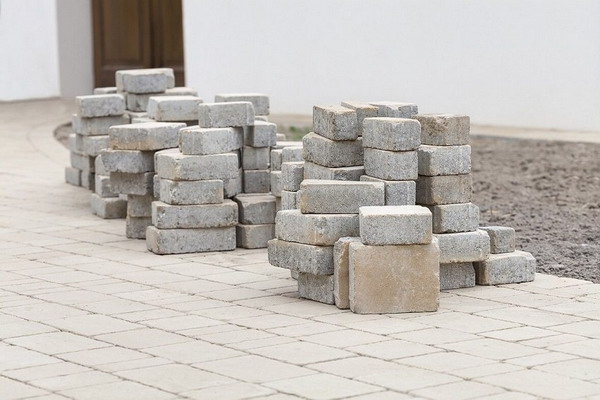
Paving slabs are a functional covering for a house adjoining territory
The use of the mixture for laying paving slabs, work with asphalt
In some cases, it is possible to lay paving slabs on an asphalt surface. This technology is performed when there is no desire to dismantle the old asphalt pavement.
The advantage of this method is the savings, since paving will require a minimum layer of solution. Enough of a few centimeters, since the asphalt itself performs the function of a base and an amplifier.
The disadvantage of the technology, which is based on working with asphalt, is that the preparatory phase involves filling the pits and voids in the coating, filling cracks and even removing broken areas. You need to spend a significant amount of time and effort to prepare the work surface for laying blanks.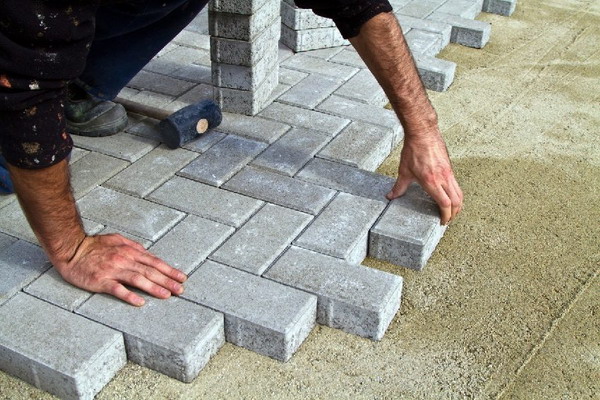
There are many options for laying paving slabs.
The technology of paving on a dry mixture for laying paving slabs is simple to perform. The main thing at the same time is to strictly observe the entire technological process of creating a pillow consisting of crushed stone and sand. Despite the obvious simplicity, you still have to be patient and accurate if you want to get a high-quality and reliable coating.
They will help you figure out how to lay paving slabs in the sand, video tutorials and other instructions.
The choice of tiles for paths in the country: prices for materials and services
The most popular basis for creating sidewalks and paved areas remains a sand cushion. The technology is quite simple and accompanied by minimal effort, so many prefer the method of laying paving slabs on the sand.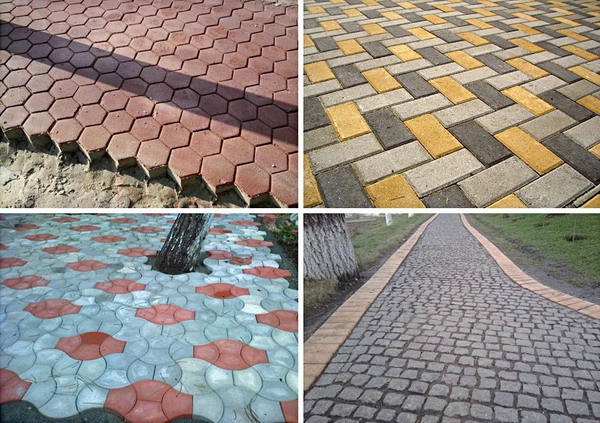
Tile design options
Helpful advice! Sand cushion allows you to lay almost any kind of tile coverings. Use this base to work with sand-polymer workpieces.
This technology will be especially useful in two cases:
- You have not yet decided on the design of the garden or are planning to make any changes in the design of the yard in the future.
- Do not want to spend time on the implementation of long and complex work related to the formation of a multilayer concrete base.

Well-groomed garden paths and beautiful grounds near the house will give the site an aesthetic look
There are several criteria for selecting material for laying paving slabs on sand with cement. First, you need to look at the performance characteristics of paving blanks. Secondly, you should carefully select the shape of the products, as well as the colors, so that subsequently the coating fits well into the overall exterior of the courtyard.
Laying paving slabs in the country: the rules for the selection of blanks
The modern range of paving slabs offers many products that differ from each other in shape, color, thickness, material of manufacture, as well as the technology of creation.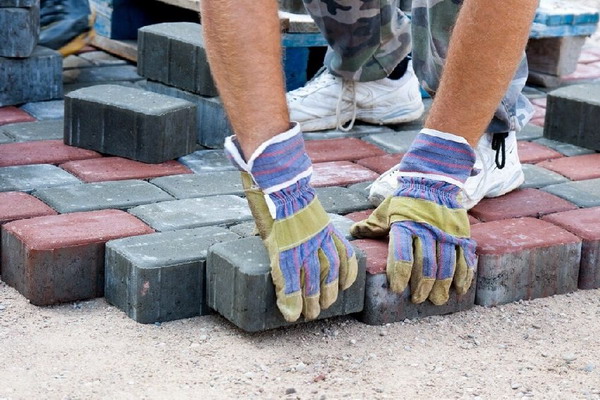
For work, you will need rubber knee pads and waterproof gloves
In order to choose the optimal coating option, you should consider the tile within the following criteria:
- The maximum loads that the product can withstand.
- What texture does the tile surface have? It can be rough or smooth.
- Will material cutting be required? It depends not only on the design of the track, but also on the shape, as well as the size of the tile itself.
- Will it be necessary to select a picture.

Laying scheme of paving slabs on sand and dry mix
Each type of tile puts forward its own requirements for the foundation. This factor should also be considered when choosing a material.
Helpful advice! Determine the type of soil in the area where the track will be staked. Mobile types of soils can create problems even for pedestrian paths, so you need to equip a concrete base. While on dense ground, you can lay a cover under the car, even on a sand cushion.
The choice of tiles depending on the purpose of the coating:
| Purpose of coverage | Type of tile blanks | The thickness of the workpieces, cm | Required substrate type (cushion) | Ability to do paving yourself | The price level for the purchase of material |
| Pedestrian | Vibrocast | 2.5-4 | Sandy | Yes | low |
| Industrial | Vibro-pressed | 6-8 | Sandy, concrete | no | tall |
| Road | Vibrocast | 4-6 | Sand and cement | Yes | middle |
The choice of blanks and the price of laying turnkey paving slabs
Almost everyone will be able to correctly lay such a covering option as paving slabs on the sand. Especially if you take into operation simple forms of blanks and the most common schemes for paving them.
There are many forms of tiled products for paving sidewalks, the most common of them:
- Gzhel – the blank is covered with curly patterns;
- honeycombs – the tile has the shape of a hexagon;
- Clover – blanks can have both a rough surface (square shape of the tile without corners) and smooth (blanks of complex shape);
- scales – has similarities with fish scales (used to create volumetric coverage);
- wave – looks like slate;
- parquet – blanks with an uneven surface, reminiscent of “Iris” candy.

The color scheme of rubber paving slabs
Note! The color range of paving materials is quite extensive and includes the following shades: burgundy, gray, green, yellow, red, orange, brown, etc.
Laying paving slabs (cost per square meter):
| Type of work | Price, rub / m² |
| Paving + sand and crushed stone formation | from 1600 |
| Ready paving | from 400 |
| Paving + concrete pad formation | from 3350 |
| Concrete foundation preparation | from 1750 |
| Preparing crushed stone pillows | from 100 |
| Paving on a sand-crushed stone pillow using a mixture | from 1700 |
| Installation of borders (linear meters) | from 120 |
Laying paving slabs: what sand is needed for work
Getting started, not many people think what sand to use for laying paving slabs in their yard. The fact is that there are many variations of this material, which has a different origin, fraction size and operational characteristics.
On the market there are even artificial analogues of sand, which have an extensive scope in construction. Therefore, it is worth seriously considering the question of which sand for laying paving slabs is best used in their work.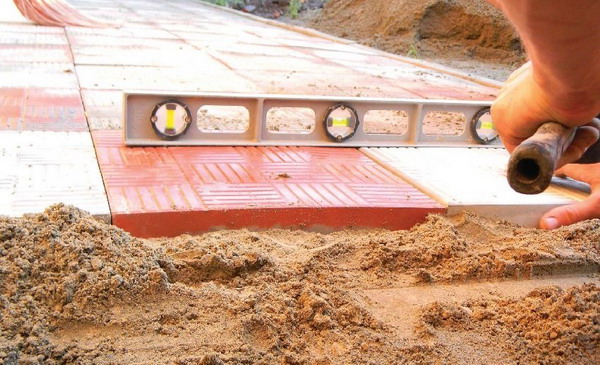
Laying paving slabs should be done on a flat area
The most commonly used varieties of sand are river and quarry. The last option is obtained as a result of natural weathering of rocks. Under the influence of strong gusts of wind, the rock undergoes slow destruction, and the sand that forms during this accumulates nearby.
Fractions (grains of sand) of this bulk material can have both large and small sizes. Since quarry sand is a naturally occurring material, by definition it cannot be 100% pure. As a rule, quarry sand incorporates various impurities. Most often clay is mixed with the material. Due to its uneven surface, quarry sand provides good adhesion to other coating components.
Helpful advice! Before laying paving slabs in the country, prepare quarry sand for work. Material must be sieved.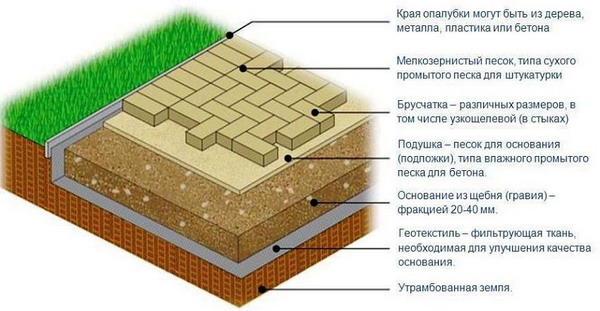
The scheme of preparation of the base for laying tiles on sand
River sand is characterized by a smooth surface, which is obtained due to the long processing of the stone with water. Such a material has a beautiful appearance, there are no impurities in its composition. River sand can be classified as environmentally friendly building materials.
The smooth surface of river sand allows water to pass through well. Therefore, to prepare the sand-cement mixture for laying paving slabs and other types of work, it should be used. Lower cost than quarry material is another advantage to existing advantages.
Dry mix for laying paving slabs: consumption and features
The preparation of a sand-cement mixture for laying paving slabs is carried out in several ways. In the first case, it can be prepared at home for use in domestic purposes. Formulation is usually straightforward.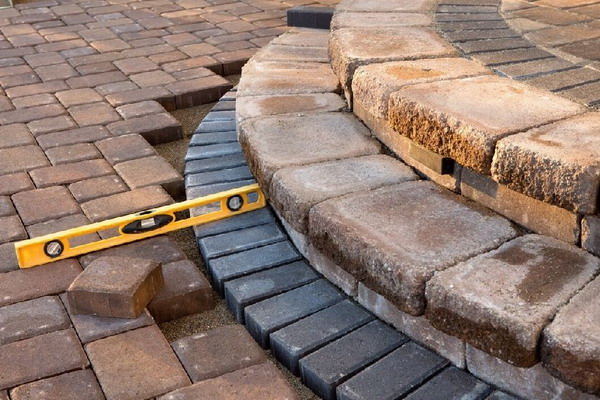
With high-quality laying, tiles can last more than 15 years
In the second case, if it is intended to be used for production purposes, exact compliance with all formulation requirements and proportions will be required.
To prepare a mixture at home, on the basis of which paving slabs will be laid with your own hands in the country, take care of the presence of:
- concrete mixer or container for mixing components (volume not less than 25 l);
- drill equipped with a mixer nozzle for mixing components;
- all components: water, cement, sand.
Note! You can add special mineral additives to the composition, which will enhance the strength of the coating, and dye, if you want to give the base a certain color and emphasize the color of the tile.
The proportions of the mixture for laying paving slabs can be very different. It depends on the recipe and the characteristics that you want to achieve in the end.
Laying strips of paving slabs
Common recipes:
- the proportion of sand and cement is 1.5: 1, respectively. The components need to be mixed well and gradually add water to them. When adding liquid, be sure to continue mixing the mixture until it reaches the consistency of thick homemade sour cream;
- You can also use the proportions of the dry mix for laying paving slabs, while using buckets as containers for measuring. Take a bucket of 10 l and fill it 7 times with sand. After that, fill the same bucket with cement twice. It is better for these purposes to take cement brand M400 or M500. It will take 15 liters of water. To begin with, mix 7 liters of liquid and 2 buckets of sand. Spend at least 30 seconds on the thorough mixing process. After that, add another 6 liters of water and the entire volume of cement that you previously measured. After 2 minutes of mixing, the remaining components are added to the composition. As a result, you should get a thick mixture that does not have stickiness. Before laying, mix all the components for 3 minutes;
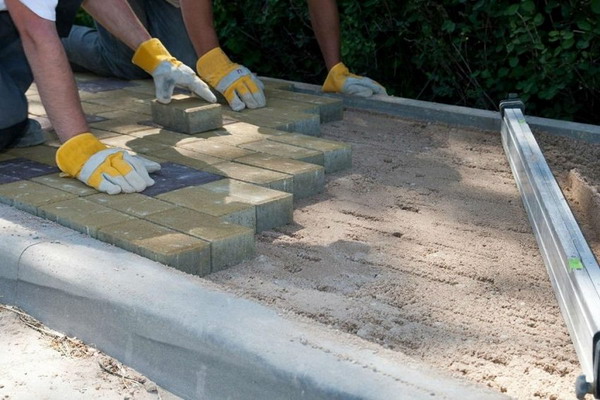
After laying the paving slabs must be carefully tamped
- the formulation with mineral additives is used in cases where it is necessary to increase the level of frost resistance of the coating and give the mixture additional elasticity. To prepare 1 m³ of the mixture, take 550 kg of dry cement of the M500 grade, 5.5 kg of C-3 plasticizer (mineral additive) and 1650 kg of sand. After mixing the loose components, add water until you have a plastic mass that can be rolled up.
Laying paving slabs: what geotextiles are needed for work
The use of geotextiles for laying paving slabs is determined by a large list of advantages that this material provides.
Garden path from paving slabs in the country
Geotextile advantages :
- high level of resistance to decay processes;
- resistance to the damaging effects of chemicals, as well as factors of physical properties;
- invulnerability to insects and small rodents;
- increased resistance to ultraviolet radiation.
Due to this, the material is in high demand in the market, so the range is striking in its diversity.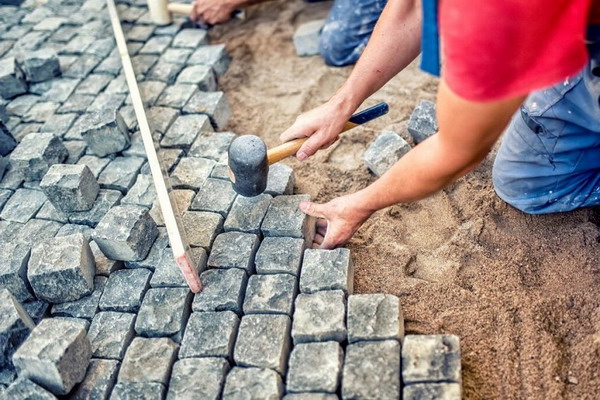
Garden path laying process
Most popular brands:
- SpanBel, Aquaspan (Belarus);
- Geotex (Czech Republic);
- Secutex (Germany);
- Terram (UK);
- Taipara (USA).
Prices are based on performance and specifications. The price is also affected by the width of the material web.
 Simple masonry pavement garden path
Simple masonry pavement garden path
Features of paving slabs on sand
Additional recommendations for laying paving slabs on a sand cushion:
- If you have to work with soft soil, when forming a sandy foundation, moisten the soil with water before tamping.
- The optimum depth of the sand base is 30 cm.
- Lay geotextiles under the sandy layer to prevent the germination of weeds.
- Use special crosses when paving to achieve equal gaps between the tiles.
It will help you learn in more detail how to lay paving slabs on the sand, video material, which is presented below.
Subject to the correct selection of materials (sand, geotextiles, cement, tile blanks, borders, dry mix) and full adherence to the technology, you can get a really high-quality, reliable, strong and durable coating, and without the involvement of specialists.


